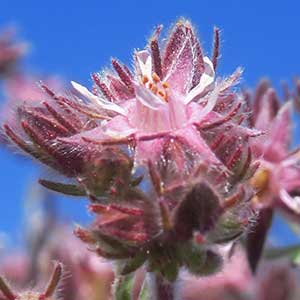Horkelia hendersonii
Horkelia fusca
Henderson's horkelia
dusky, dusky horkelia, horkelia, pinewoods, pinewoods horkelia, pink pinwheels, tawny horkelia
ascending to erect, 0.8–2(–2.5) dm.
3–8 × 0.7–1.5 cm;
leaflets (5 or)6–12 per side, overlapping at least distally, cuneate to flabellate, 4–9(–10) mm, divided 1/2+ to midrib into 3–6 oblanceolate to obovate lobes (often medially notched more than 3/4 to midrib as well), silky villous.
(3–)4–20(–40) × (1–)1.5–4(–7) cm;
leaflets narrowly cuneate to obovate to flabellate, 5–30(–35) × 2–20(–30) mm, 1/3 as wide to wider than long, divided into linear or oblanceolate to obovate teeth or lobes, sparsely to ± densely short-villous or hirsute, sometimes glabrate.
2–3.
1–5(or 6).
2–8(–10) mm.
(2–)4–15(–20), 10 mm diam.;
epicalyx bractlets linear, 2.5–4.5 × 0.2–0.5 mm, 2/3 to nearly equal to length of sepals;
hypanthium 1–2.5 × (2–)3–4(–5) mm, ± 1/2 as deep as wide, interior densely villous;
sepals spreading, narrowly lanceolate, 3.5–6 mm, silky hairs silky, 1–1.5 mm;
petals often pink-tinged, linear to narrowly oblanceolate, 2.5–5 × 1 mm, apex ± acute to narrowly rounded, sometimes slightly mucronate;
filaments pinkish, 2 × 0.5–0.7 mm, glabrous or sparsely pilose adaxially, anthers 0.5–0.7 mm;
carpels 8–17;
styles (1.5–)2–3 mm.
5–12 mm diam.;
epicalyx bractlets 1–3 mm, 1/2 length of to nearly equal to sepals;
hypanthium 1–3 × 2–4 mm, 1/2 to nearly as deep as wide;
sepals spreading to ± reflexed, narrowly to broadly lanceolate, (1.7–)2–4(–4.5) mm;
petals 2–6(–6.5) mm;
filaments 0.2–1.5 × (0.2–)0.4–0.6(–1) mm, anthers 0.4–0.6 mm;
styles 0.9–1.5 mm.
dark brown, 2 mm.
brown.
Horkelia hendersonii
Horkelia fusca
Of conservation concern.
Horkelia hendersonii is one of the more attractive species of the genus, with its grayish mats and dusky pink inflorescences. P. A. Rydberg (1898) placed it initially in his group Capitatae, here restricted to H. fusca, and later (1908c) transferred it to his new group Tenuilobae, which otherwise comprised only H. tenuiloba. The species is known only from Jackson County, Oregon, and an isolated population in adjacent Siskiyou County, California. The populations are vulnerable due to their proximity to popular recreational sites.
(Discussion copyrighted by Flora of North America; reprinted with permission.)
Varieties 7 (7 in the flora).
Horkelia fusca represents the primary radiation of the genus beyond the California Floristic Province. Within California, H. fusca occurs in the Sierra Nevada and mountains of northern California, and it is the only representative of the genus extending beyond California and Oregon into Washington, Idaho, Nevada [with the possible exception of H. tridentata (10e. sect. Tridentatae) in Washoe County], and, questionably, Wyoming.
As here circumscribed, Horkelia fusca is the most diverse, most widely distributed species in the genus, with significant additional work needed to fully elucidate its variation patterns. The treatment presented here differs from that of D. D. Keck (1938) and B. Ertter (1993d) in using the rank variety instead of subspecies, circumscribing var. capitata more narrowly, and transferring the application of var. pseudocapitata from what is here called var. brownii to the bulk of what had been subsp. capitata (Lindley) D. D. Keck (B. Ertter and J. L. Reveal 2007).
There are two types of basal leaves in plants of Horkelia fusca. The ephemeral early-season leaves have leaflets that tend to be broadly cuneate-obovate, shallowly toothed, densely glandular but otherwise sparsely hairy, and deeply veined. The leaf features described below are drawn from the more persistent, mid season leaves that predominate at peak flowering and differ more strongly among varieties.
Petals of first-formed flowers are often larger than average; end-of-season petals can be smaller than average.
Although Montana is sometimes included in the range of Horkelia fusca, such references are based only on potential occurrence (W. E. Booth and J. C. Wright 1959).
(Discussion copyrighted by Flora of North America; reprinted with permission.)
1. Leaflets divided ± 1/2–3/4+ to midrib | → 2 |
1. Leaflets divided less than 1/2 to midrib | → 4 |
2. Inflorescences usually with flowers arranged individually; sw Oregon. | var. filicoides |
2. Inflorescences composed of 3–20-flowered glomerules, (flowers rarely arranged individually in var. fusca); ne California, nw Oregon, sw Washington | → 3 |
3. Leaflets divided ± 1/2 to midrib, 5–18(–20) × 4–15 mm; petals 3–5 mm; filaments 0.5–1.3 mm, longer than wide; nw Oregon, sw Washington. | var. fusca |
3. Leaflets divided 3/4+ to midrib, 5–10(–15) × 2–10(–20) mm; petals 2–3(–4) mm; filaments 0.2–0.5 mm, wider than long; ne California. | var. tenella |
4. Leaves grayish, surfaces often obscured, ± densely short-villous; leaflets narrowly to broadly cuneate, usually 1/3–1/2 as wide as long; ne California, adjacent Oregon and Nevada. | var. brownii |
4. Leaves green, surfaces not obscured, ± short-hirsute, villous, or glabrate; leaflets cuneate to broadly obovate, 1/2 to wider than long; California to Washington, Idaho, Wyoming | → 5 |
5. Inflorescences dark reddish purple, densely congested, bracts acuminate-lobed, obscuring pedicels and flowers even at maturity, glandular hairs usually conspicuously red-septate; epicalyx bractlets (2–)3.5–5(–6) mm; cauline leaves 3–6, leaflets of proximalmost 3–5 per side; ne Oregon, se Washington, n Idaho. | var. capitata |
5. Inflorescences green to reddish purple, congested to open, bracts acute-lobed, not obscuring pedicels and flowers at maturity, glandular hairs not or obscurely red-septate; epicalyx bractlets 1–3.5(–4) mm; cauline leaves 1–4(or 5), leaflets of proximalmost 2–4(or 5) per side; Cascade-Sierra axis of Oregon, California, e to Wyoming and n Nevada | → 6 |
6. Petals (3–)4–6 mm; leaflets 10–30(–35) × (5–)10–20(–25) mm; epicalyx bractlets 2–3.5(–4) mm; mountains in and bordering n Intermountain Region, ne California, n Nevada, se Oregon, s Idaho. | var. pseudocapitata |
6. Petals 2–4.5(–6.5) mm; leaflets 5–15(–20) × (2–)5–10(–15) mm; epicalyx bractlets 1–2(–3) mm; Sierra Nevada, California and Nevada, to Cascade Ranges, c Oregon, and mountains of c Idaho, adjacent Wyoming. | var. parviflora |


